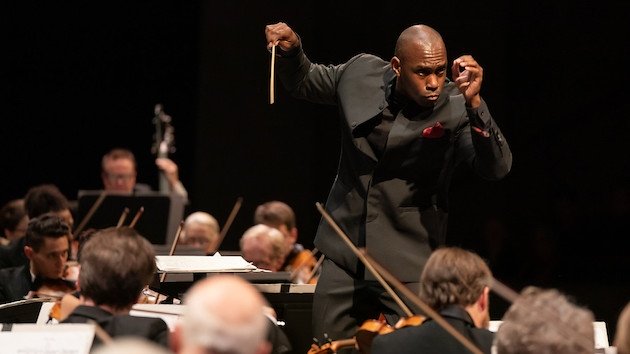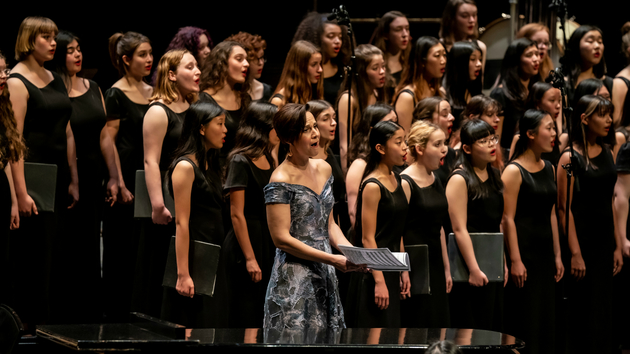
Berkeley Symphony pulled out the Brahms Symphony No. 1 on Thursday night and, with a large string section leading the way, did a first-rate job with it. But that was clearly not the main story. The focus of the concert, in the centenary year of the passage of the 19th Amendment, was on two works celebrating women and feminism, with the Brahms tacked on because, well, bums in seats.
Bryce Dessner’s song cycle Voy a dormir (I am going to sleep), premiered in 2018, comprises settings of poems by Alfonsina Storni (1892–1938). Storni, in addition to being a pioneering writer in the male-dominated Argentine literary world of the period, was also a feminist and campaigner for civil rights for women. Her life ended tragically when her breast cancer reappeared after she had undergone a radical mastectomy. She committed suicide by drowning herself in the water of Mar del Plata. Shortly before, she published the poem that is the title of Dessner’s work and its anchor as well.

That poem can certainly be read as a suicide note, even if it wasn’t intended that way, for it is obviously about impending death: “oh sweet nursemaid, / turn the earthly sheets down for me / and prepare my quilt of carded moss.” All of the poems in the cycle are extraordinarily rich, stronger, I think, than Dessner’s settings, but his music suits their lyricism and rises to the dramatic in an effectively scored and pointed finale, a song that is almost as long as the other three in this set combined.
That last song exerts a pull on the rest of the settings, as the composer tries to find poems that will fit with “Voy a dormir” and form a cycle. The piece begins with the whimsical “Yo en fondo del mar” (Me at the bottom of the sea), lightly scored, with much of the twinkly musical material coming from the piano part. However, even there, the vocal setting (for mezzo-soprano Kelley O’Connor, for whom the piece was written) didn’t reflect the playfulness of the poem, and I was waiting for more of a response from the composer to the danceable parts of the poem: “sing and dance / the blue-green sirens / of mother of pearl,” or “a squid / winks at me.” The beautiful vocal lines were lovingly sung by O’Connor, but there are more emotional beats in these poems than Dessner’s music registers.

Mary Kouyoumdjian’s Become Who I Am is about the experiences and outlook of girls and is scored for prerecorded voice track, girls’ chorus, and string quartet. It’s one of what she calls her “documentary pieces,” and in key aspects it does sound like a radio documentary. Kouyoumdjian interviewed members of the Brooklyn Youth Chorus, asking them questions like “what makes you passionate?” “what makes you confident?” “what makes you insecure?” She edited the answers into a recorded track that forms the base of her piece. The San Francisco Girls Chorus (in this case) calls out some of the answers in measured, declamatory, chordal singing, which is overlaid with a faster-moving rhythmic accompaniment from the quartet.

It would be normal to reverse this layering and focus on “purely musical” aspects of what the musicians are doing. Indeed, the piece that seems to be in the background of this piece and others of Kouyoumdjian’s documentary pieces, Steve Reich’s Different Trains, does bind a spoken track to the string quartet music by deriving musical motives from speech patterns and emphases.
But Become Who I Am is actually focused on the experience of the speakers, the prerecorded voices telling their own stories. Kouyoumdjian is content to merely underline the spoken testimony in the chorus parts (which doesn’t mean that the vocal writing or singing was incidental to the piece.) The composer’s editing of the spoken parts is the most expressive part of this music. The tempo for the piece is established by the editing, which happens right up front, when the girls (and one boy) state their ages and gender. This becomes a kind of incantation in the echoing of the chorus. When the editing speeds up, the quartet accompaniment responds with more rhythmic activity and more aggressive accents. The recorded track also cues the climaxes, particularly toward the end when the speakers opine on gender equality.
In its roughly 10 minutes’ length, Become Who I Am manages to say a lot because the speakers have a lot to say. Kouyoumdjian just wants us to hear them.
I did love Music Director Joseph Young’s interpretation of Brahms’s First Symphony, even though no new ground was broken. It was well-balanced and energetic, with some beautiful playing from principal clarinetist Roman Fukshansky in the third movement solos. The massive fourth movement had drama but also the kind of plush sound you might expect from the SF Symphony. It’s just that I felt the urgency of Become Who I Am, while Brahms’s First seemed more like an old friend who you’re glad to hear is still doing well.




